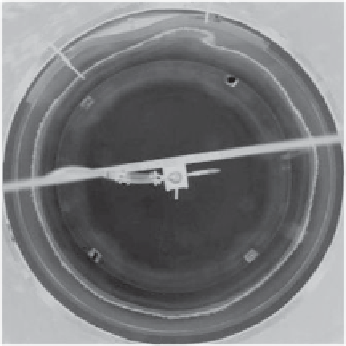Geoscience Reference
In-Depth Information
(a)
Deformable wall
Dye dispenser
Water level
(b)
Inner wall
Dye line
Shelf
Rotating table
Cylindrical tank
Figure 12.2.
Photographs of (a) the rotating tank with elements of the experimental labeled and (b) our reference experiment from
the overhead camera. The photograph in panel (a) was taken before attachment of the experimental slope in order to distinguish
the shelf and before the base of the tank was repainted for the experiments.
5. Our experiments omit variations in density, which
are dynamically important throughout the ocean. How-
ever, the barotropic dynamics are still informative, and
strongly barotropic velocity profiles have been observed
in the Agulhas current [
Bryden et al.
, 2005;
Beal et al.
,
2006].
All of the results described below concern shelf waves
generated in the lee of a continental headland that pro-
trudes out onto the continental shelf. In the laboratory we
constructed a bump by attaching a sheet of plexiglass to
the outer wall of the tank and then forcing its center out
onto the shelf by placing a wedge behind it. This appara-
tus is visible in Figure 12.2. The outer wall of the channel
is therefore given by
r
=
R
b
(θ)
. The bump in our annu-
lar channel, which was held fixed in all of the experiments
below, is accurately described by
the evolution of the dye line using an overhead camera
that corotates with the tank, producing images like those
shown in Figure 12.3. We generate a mean flow, represent-
ing along-shore transport by a coastal current, by rapidly
changing the Coriolis parameter of the tank from
f
−
f
to
f
. This imparts a relative vorticity of
f
to all of
the water in the tank, inducing an azimuthal flow with
sign opposite to that of
f
. For all of the experiments
described herein, we use
f
>
0, yielding a retrograde
coastal current. We found that a retrograde current would
develop large-amplitude shelf waves in the lee of the
coastal protrusion, whereas a prograde current would not.
This phenomenon may be understood via the nonlinear
shelf wave theory described in Section 12.4.
Clarke and
Johnson
[1999] showed that waves with the smallest ampli-
tudes have the largest phase speeds unless the shelf line lies
very close to one of the channel walls. Thus, disturbances
formed by a prograde coastal current propagate rapidly
downstream as small-amplitude waves, preventing a large
wave envelope from forming on the continental shelf.
We have performed experiments over a range of
tank rotation rates
f
−
W
b
(θ)
,
W
b
(θ)
=
W
b
0
sech
2
θ
,
−
θ
b
b
R
b
=
R
c
−
(12.1)
where
W
b
0
= 8.3cm,
θ
b
= 1.82rad, and
b
= 0.18rad.
At the maximum extent of the protrusion, the width of
the experimental shelf is reduced to 3.5cm. This shape has
been chosen to produce long waves with large amplitudes,
which may be expected to exhibit nonlinear behavior with-
out breaking.
In each experiment, we rotate the tank at a constant rate
until the water within is brought to rest in the rotating
frame. We then inject a line of dye into the fluid sur-
face over the center of the slope at the PV front. This
dye line serves as a passive tracer, intended to track the
PV front as it is advected around the channel. We track
rad
/
s d
coastal current speeds corresponding to
f
∈{
∈{
1,1.5,2,2.5,3
}
0.01,
0.02,
...
,0.07
rad
/
s. For the purpose of illustration,
we define a reference experiment with
f
= 1.5rad
/
sand
f
=0.03rad
/
s that characterizes the evolution of the
shelf waves generated by our coastal current. Figure 12.3
shows images of the dye line close to the coastal protru-
sion at several times in this experiment. Between
t
=0s
and
t
= 17s, the coastal current advects fluid past the
protrusion, developing a long wave with large amplitude.
The rear portion of the wave then steepens continually
}

















